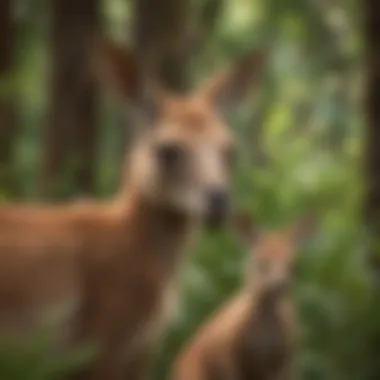Unveiling the Enigmatic World of Kangaroos through LeafLearners


Nature Topic Overview
Kangaroos, the captivating marsupials renowned for their exceptional hopping prowess and unique maternal care practices, invite us to delve into their intriguing world with LeafLearners. From the vast open plains of Australia to the dense eucalyptus forests, kangaroos thrive in diverse habitats, playing a vital role in the delicate ecosystem.
Fun Facts and Trivia
Did you know that kangaroos can jump up to 30 feet in a single bound? Their powerful hind legs enable these iconic creatures to cover impressive distances with minimal effort. Moreover, joeys, baby kangaroos, remain nestled in their mother's pouch for several months, receiving nourishment and protection until they are ready to explore the world on their own.
Wildlife Explorations
Within the realm of kangaroos, explore fascinating variations among species, such as the agile red kangaroos and the tree-dwelling tree-kangaroos. Delve into the unique adaptations of kangaroos, from their elongated tails for balance to their specialized digestive system that aids in digesting tough plant material. Engage in interactive quizzes to test your knowledge of these marvelous marsupials and their habitats.
Environmental Awareness
Discover the crucial significance of conserving kangaroos and their habitats to maintain ecological balance. Learn about the impact of human activities on kangaroo populations and habitats, highlighting the importance of sustainable practices to ensure the survival of these iconic creatures for future generations. Explore practical tips on how children can contribute to protecting nature and preserving kangaroo habitats.
DIY Nature Activities
Embark on hands-on activities to immerse in the world of kangaroos. Create pouch-inspired crafts using simple materials, mimicking the nurturing environment of a kangaroo's pouch. Venture outdoors to observe kangaroo habitats firsthand, studying their natural behaviors and interactions with the environment. Engage in step-by-step guides for creating nature-inspired projects that celebrate the beauty and significance of kangaroos in the wild.


Foreword to Kangaroos
In this article, we embark on a detailed exploration of kangaroos, aiming to unveil the unique traits and behaviors that make these mesmerizing creatures stand out in the animal kingdom. Delving into the evolutionary history and physical characteristics of kangaroos enables us to grasp the roots of their existence and better appreciate their exceptional adaptations. Understanding the intricacies of kangaroos' habitats and distribution sheds light on their survival strategies in diverse environments. By investigating their behavioral patterns, we can uncover the complexities of social structures, feeding habits, and reproductive strategies that shape their lives. Exploring the iconic features of kangaroos, such as their unparalleled hopping locomotion and remarkable maternal care, offers a glimpse into the distinctive aspects of their existence. Finally, delving into the ecological significance of kangaroos highlights their vital role in maintaining ecosystem balance and underscores the importance of their conservation.
Evolutionary History of Kangaroos
The evolutionary history of kangaroos traces back millions of years, showcasing a remarkable journey of adaptation and survival. These marsupials have evolved unique traits that distinguish them from other species, reflecting the selective pressures they've faced over millennia. Exploring the ancestral origins of kangaroos unravels fascinating insights into their early development and the key evolutionary stages that led to their current form. By dissecting the genetic and morphological changes that have shaped kangaroos over time, we can appreciate the intricate process of natural selection and environmental adaptation that have sculpted their biology.
Physical Characteristics
The physical characteristics of kangaroos offer a captivating glimpse into their anatomy and structural features, showcasing a blend of specialized adaptations for movement and survival. From their powerful hind legs designed for unparalleled hopping agility to their muscular tail that provides balance and support, every aspect of a kangaroo's physique serves a distinct purpose. Exploring the sensory organs, fur texture, and dental structure of kangaroos unveils a comprehensive picture of how these animals interact with their environment and procure sustenance. Understanding the unique aspects of kangaroo physiology not only deepens our admiration for their biological complexity but also underscores the beauty of evolutionary diversity in nature.
Habitats and Distribution
Native Habitats
Kangaroos are primarily found in Australia, their native habitat comprising diverse landscapes such as forests, grasslands, and deserts. These regions offer varying vegetation and climate conditions, influencing kangaroos' behaviors and foraging patterns. The evolution of kangaroos in these distinct environments showcases their remarkable adaptability to different ecological niches. Understanding their native habitats is pivotal in comprehending the evolutionary journey of kangaroos and the ecological pressures that have shaped their traits.
Global Distribution


Apart from their native Australia, kangaroos have a scattered global distribution in countries like Papua New Guinea and Indonesia. Their presence in different parts of the world highlights their ability to inhabit diverse habitats beyond their primary range. Exploring their global distribution unravels the factors contributing to their dispersal and survival in varied ecosystems, emphasizing their resilience as a species. Observing the distribution patterns of kangaroos provides valuable insights into their adaptability and evolutionary success on a broader geographical scale.
Adaptations to Environment
Kangaroos exhibit remarkable adaptations to their environments, such as their unique locomotion style using hopping as a primary mode of transportation. This specialized trait enables them to navigate through various terrains efficiently, conserving energy while moving swiftly. Additionally, their physiological features, like efficient water conservation mechanisms and heat regulation abilities, help them cope with challenging environmental conditions. Exploring their adaptations sheds light on the intricate ways kangaroos have evolved to thrive in diverse habitats, showcasing their biological versatility and resilience.
Behavioral Patterns of Kangaroos
In this detailed exposé on the captivating world of kangaroos, the section dedicated to their behavioral patterns serves as a crucial focal point. Understanding the Behavioral Patterns of Kangaroos offers a peek into the intricate social structures, feeding habits, and reproductive strategies employed by these fascinating marsupials. By delving into their behavioral tendencies, readers can grasp the nuanced interactions within kangaroo communities and how these behaviors contribute to their survival in diverse ecosystems. From deciphering their unique communication methods to unraveling their foraging patterns, exploring the Behavioral Patterns of Kangaroos sheds light on the complexity and adaptability of these iconic Australian creatures.
Social Structure
The Social Structure of kangaroos unveils a tapestry of interconnected relationships and hierarchies within their communities. With a social order based on age, size, and gender, kangaroos exhibit distinct behaviors that shape their interactions. From hierarchical dominance displays to cooperative group dynamics during times of danger or scarcity, the Social Structure plays a pivotal role in ensuring the survival and well-being of the group as a whole. Observing the Social Structure of kangaroos provides valuable insights into how they navigate challenges, form alliances, and maintain balance within their dynamic societies.
Feeding Habits
Exploring the Feeding Habits of kangaroos unveils a fascinating array of dietary preferences and foraging techniques. With a primarily herbivorous diet, kangaroos rely on a variety of grasses, plants, and shrubs to meet their nutritional needs. Their feeding habits are not only essential for sustaining energy levels but also play a crucial role in shaping their environment through grazing behaviors. Understanding the dietary choices and feeding strategies of kangaroos offers a glimpse into their ecological impact and the delicate balance they maintain with their surroundings.
Reproductive Strategies


The Reproductive Strategies employed by kangaroos are as intriguing as they are essential for species survival. From delayed implantation mechanisms to synchronized breeding seasons, kangaroos have evolved unique adaptations to maximize reproductive success in challenging environments. By examining their reproductive strategies, one can unravel the intricate dance of courtship rituals, mating behaviors, and maternal care practices that contribute to the perpetuation of kangaroo populations. Delving into their reproductive biology offers a deeper appreciation for the tenacity and resilience exhibited by these amazing marsupials.
Unique Features of Kangaroos
Kangaroos possess a plethora of unique features that set them apart in the animal kingdom. In this article, we will delve into these exceptional characteristics, shedding light on the remarkable adaptations that have allowed kangaroos to thrive in their respective environments. Understanding the nuances of these unique features is crucial for appreciating the evolutionary journey of these fascinating marsupials. From their distinctive hopping locomotion to their specialized maternal care practices, each aspect contributes to the holistic understanding of kangaroos as unique and irreplaceable beings.
Iconic Hopping Locomotion
One of the most striking features of kangaroos is their iconic hopping locomotion. This distinctive method of movement is not only mesmerizing to witness but also serves a crucial purpose in their survival. The efficiency and speed of their hops enable kangaroos to cover vast distances with minimal energy expenditure, a trait that is crucial for foraging and evading predators. Through a detailed exploration of this fascinating locomotion style, we will uncover the intricate biomechanics and evolutionary advantages that have sculpted kangaroos into the unparalleled hoppers that they are known to be. From discussing the unique muscle mechanics involved in hopping to unraveling the impact of this locomotion on their overall physiology, this section will offer a comprehensive insight into why kangaroos hop and how it distinguishes them from other creatures.
Pouch and Maternal Care
The pouch and maternal care system of kangaroos stand out as another exceptional feature that contributes significantly to their evolutionary success. The iconic image of a joey nestled snugly in its mother's pouch is not just adorable but also serves as a testament to the remarkable adaptation of kangaroos. Exploring the intricacies of this unique reproductive strategy, we will uncover the functional advantages of pouch development and how it streamlines the nurturing process for kangaroo mothers. Additionally, we will delve into the deep bond between mother and offspring, examining the behavioral patterns that underline the importance of maternal care in the survival of kangaroo populations. By shedding light on the role of the pouch in supporting joey development and the symbiotic relationship between mothers and their young, this section aims to underscore the profound significance of maternal care in shaping the resilience and adaptability of kangaroos.
Ecological Significance of Kangaroos
Kangaroos play a vital role in the delicate balance of various ecosystems, particularly in Australia where they are native. Their presence influences plant diversity by grazing on vegetation, shaping the landscape. By consuming different types of plants, kangaroos prevent any one species from dominating, thus promoting biodiversity. Additionally, their feces act as natural fertilizers, enriching the soil and aiding in the growth of diverse plant species. This symbiotic relationship between kangaroos and the environment showcases their crucial ecological significance.
Role in Ecosystem
Within their habitats, kangaroos serve as essential herbivores, playing a key role in controlling vegetation levels. They prevent overgrazing of certain plant species, which can negatively impact other animal populations dependent on those plants for food and shelter. Kangaroos also act as prey for various predators, helping to regulate predator populations and maintain a healthy ecosystem balance. Their interconnectivity with other species highlights the intricate web of relationships within ecosystems where they dwell.
Conservation Status
Despite their ecological importance, kangaroos face threats to their populations, primarily due to habitat loss, human-wildlife conflict, and hunting. Conservation efforts are crucial to ensuring the survival of these iconic marsupials. Implementing sustainable land management practices, promoting coexistence between humans and kangaroos, and enacting regulations to protect them are essential steps in safeguarding their future. By raising awareness about their conservation status, we can work towards preserving these magnificent creatures for generations to come.







